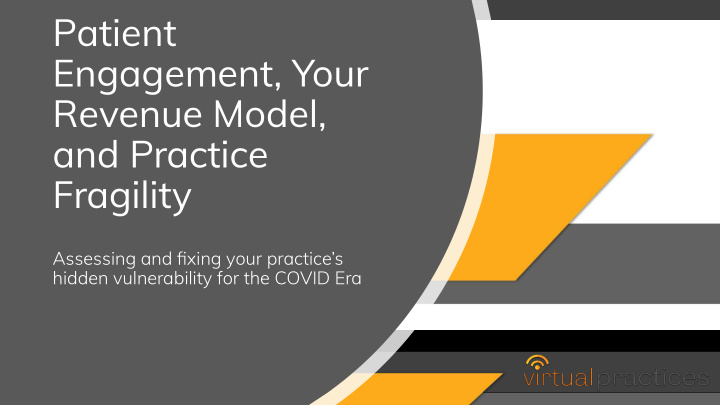



Patient Engagement, Your Revenue Model, and Practice Fragility Assessing and fixing your practice’s hidden vulnerability for the COVID Era
• If you haven’t already, register at VirtualPractices.org • Inoculate your patient and practice against future disruptions. • Understand the importance of health action plans. Objectives • Establish a revenue model that optimizes engagement (and therefore outcomes) and minimizes volatility in turbulent times. • Log your questions and send them to: impact@virtualpractices.org • Next session : The Power of Bundled Programs: How to design, build and price a bundled program – starting with COVID
Fragile Revenue Models • Visit-based vs. subscription vs. package models • Opt-in vs. opt-out with payers
Fragile Engagement Models • Fragility of patient engagement • Defined care plans vs. build it as we go
Enhancing Engagement Inoculating your patients and practice against future disruptions
• … • •
Health Action Plan • Provides a useful and valuable take-away for the patient • Creates a common reference point and context to serve the patient regardless of health or circumstances • Ensures consensus and comprehension of the path and destination • Drives engagement and adherence • Reduces attrition
Sample Plan • Identify the five key metrics that are most linked to the desired outcome. • Creates an education opportunity for patients
Sample Plan • Health Vision • Current State • Action Plan (to-do list)
Sample Plan • Medications & Supplements
Revenue Models
Structure Dictates Behavior.
About Far More Than Money • Pricing is about revenue. Revenue models are about relationships and behavior. • Patient engagement • Health outcomes • Practice fragility
DPC Memberships Since Stay-at-home Orders 1.5% Growth
Which of the following is the primary business model you use for services rendered to patients? By percent time practicing functional medicine 2016 distributions: • <30% • Cash fee-for-service: 23% • Insurance: 73% • Membership: 5% • 30%-69% • Cash fee-for-service: 44% • Insurance: 50% • Membership: 5% • 70%+ • Cash fee-for-service: 70% • Insurance: 25% • Membership: 5% % time practicing Functional Medicine >0%, US only
Relationship Structures • Options: • Fee for service (cash or insurance based) • Membership/ subscription • Program packages (bundled episodes of care) • Combinations • Key principle: Move money as quickly as possible to the background of the relationship.
Selecting Your Model • Relationship preference • Long-term vs. episodic • Patient demographics • What percentage of your practice is/will be seniors? • What percentage of your patients will have high deductibles? • Promotion • Do you have a reliable source of ongoing new demand? • Do you enjoy sales and marketing? • Are you good at it? • Can you work to a protocol?
Why is this more complicated for you than for other practitioners? • The relationship between your training and workload variability among patients. • The challenge of single tier membership models in functional and integrative medicine.
Combining Two Approaches • Bundled programs + subscription-based maintenance • With or without insurance and Medicare • Revisit the fee for non-covered service approach
Homework
• Join the Virtual Practices Facebook community • Start training patients on your virtual infrastructure. • Create a basic Health Action Plan format Homework for use with patients. • The VirtualPractices Excel version is free for you to use. • Identify the revenue model that best suits you and your practice. • Submit your questions and requests for help to: Impact@VirtualPractices.org • Next Workshop: The Power of Bundled Programs: How to design, build, and price a bundled program - starting with COVID
Recommend
More recommend